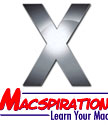
At MyMac.com, and other computer sites, terms like freeware, burn, jpeg, and more are being used all of the time. Sometimes we (the writers) take for granted that the audience understands what we are talking about. I figured I’d make a list of ten of the more common terms we might use in articles. You might look at a lot of the words below and think they are common sense. What might be common sense to you might be totally foreign to another person.
1. Download: When you view a website, or email, or anything on the internet, those files are being downloaded to your computer. In other words, they are coming from another computer, somewhere in the world, and being sent to your computer through your internet connection.
2. Font: A font is a letter style, and not necessarily a computer term. However, fonts are used all of the time in computer software, so I thought I would include it. Designers use different fonts to give text a certain feel. You can do the same thing with fonts on your computer. Sometimes fonts might be referred to as type.
3. Operating System: The operating system is what makes your computer run. It is what I would call part of the computer’s brain. Without an operating system you’d be looking at nothing when you turn your computer on. OSX Tiger is Apple’s current operating system, while Windows XP is Microsoft’s current operating system. Another operating system you might hear about is Linux.
4. Hard Drive: A hard drive would be the second part of the computer brain. The hard drive is where all your files go when you save them. It is where the operating system is stored. Think of it as a long term memory for your computer. If you need to access a file on your computer, you are probably looking in your hard drive.
5. Memory: Computer memory is like the short term memory for your computer. When you are typing a document in your computer, that document is stored in the memory until you save it to the hard drive. If you quit the program before saving the file, all of that work will be lost. The more memory your computer has the better it will run.
6. Freeware: Freeware is free software that can be downloaded to the computer. The author of the program is giving the program away for free.
7. Shareware: Shareware is software that you download and it must be paid for to keep it. Usually there are features missing from the download, or the download stops running after a certain amount of time or days. Paying for and registering the program will disable these limitations, and the program becomes yours.
8. Burn: When a person makes you a CD or a DVD they are burning the disc. Burning writes the files onto the CD or DVD. Those could be music files, images, videos, or text documents. A CD/DVD burner is used to burn a disc. Think of it as recording the CD or DVD.
9. JPEG, TIFF, GIF, PICT: These are common graphic file types. It is too complicated to get into the differences, but just know these refer to graphic files.
10. USB and Firewire: These are plugs on your computer for connecting external devices like a printer or a scanner. There are USB and USB 2.0 devices. USB 2.0 and Firewire transfer data a lot faster than USB. For example, a USB 2.0 scanner will scan and transfer an image to your computer a lot faster than a USB scanner. Many cameras use USB or USB 2.0 to connect to your computer. Many external drives and CD-burners use Firewire. If you have an iPod you are connecting to the computer with Firewire or USB.
This list could be a lot longer than ten items, but I’m going to stop here. If you have something that should have been mentioned above post it below.

Leave a Reply
You must be logged in to post a comment.